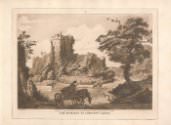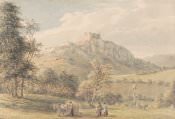Paul Sandby
Paul Sandby
An English painter and engraver, Sandby was born in Nottingham, and most likely learned his skills as a draftsman and watercolor artist from his older brother, Thomas. Sandby’s entrance into the national art scene followed the Jacobite Rebellion, after which Sandby was employed as a draftsman to map and draw the landscapes of the Scottish Highlands for military purposes. His work gave him the time to develop his landscape and figure drawing abilities. Additionally, Sandby popularized the use of aquatint, a printmaking technique that allowed more expressive qualities than older print techniques. After his work in Scotland, Sandby toured Britain extensively. In 1775, Sandby travelled to Wales, the first of many trips, and subsequently published Twelve Views in Aquatina from Drawings taken on the Spot in South-Wales (1775) and Twelve views in North Wales (1776), works that inspired many other artists to follow suit. Sandby is most remembered for his watercolors. His honest depictions of landscape and the figures found there are what makes him remembered as the father of British watercolor.


